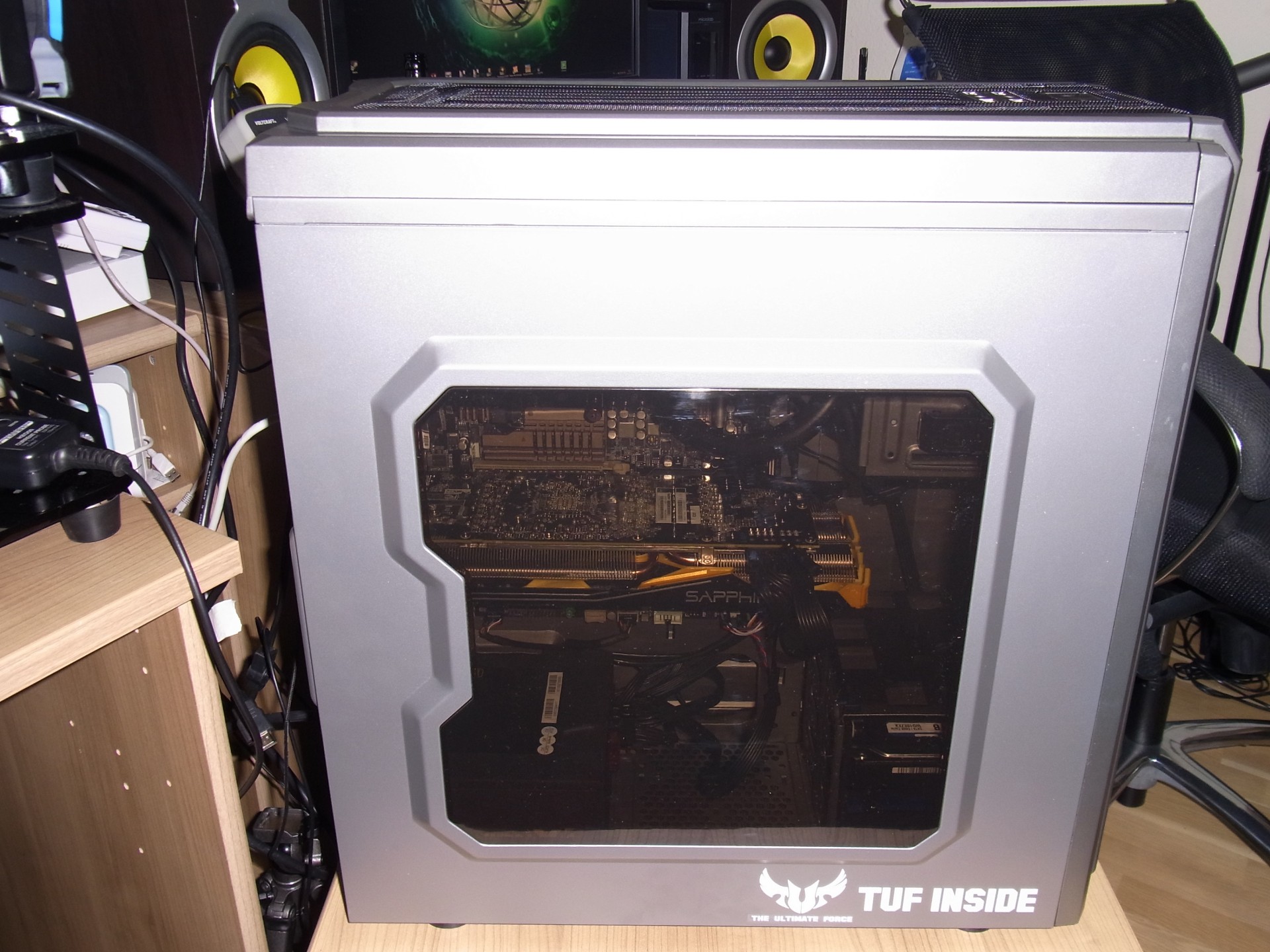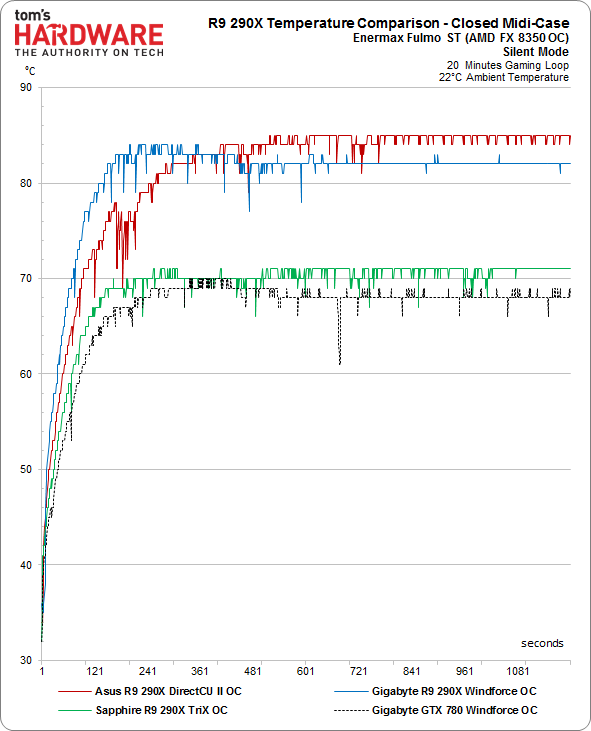Does Radeon R9 290X Behave Any Differently In A Closed Case?
We're in the process of testing Radeon R9 290X cards from AMD's board partners, and were curious how they all fare in a closed chassis. Corsair's deluxe Obsidian 900D offers lots of airflow, so we dusted off a more mainstream $80 case to test with.
Temperatures And Noise
Temperatures
The temperatures you see in the graph below show that partner boards run quite a bit cooler than AMD's reference design. In fact, Sapphire's offering even matches one of our favorite GeForce GTX 780 cards from Gigabyte. As it turns out, the Hawaii-based flagship is perfectly capable of running well in a closed case, so long as it's cooled properly.
Let's get into the results themselves. Each of these boards is tested for 20 minutes using Metro: Last Light at its highest settings.
Asus' R9 290X DirectCU II OC fares the worst, even though its 84-85 °C temperature is still bearable. The Tri-X OC Radeon R9 290X shows that Hawaii can run quite a bit cooler, though, topping out at 72 °C. Sapphire's result is particularly impressive. In our closed case test, the Tri-X registers 1-2 °C lower than in the open-air chassis. The Asus card's temperature, on the other hand, increases nine degrees from our measurement using the exposed bench system. And what's up with Gigabyte's R9 290X Windforce OC? With a reading of 83-84 °C in the closed case, that's just under Asus' board. But it's still one degree lower than our open case result. Apparently, Quiet Mode was taken too literally; a slightly faster fan would have probably been acceptable.
It turns out that the Asus and Gigabyte cards suffer the same problem. Instead of a solid base drawing heat away from the GPU, both employ evidently unfavorable direct-contact heat pipes. The tapered surfaces don't make sufficient contact with the GPU, especially the two outer pipes that essentially do nothing. A vapor chamber or massive sink would have been much more useful.
Then again, that's what you get when you recycle the same cooling found on Nvidia's GeForce GTX 780 for reasons of economics. Cheers, accountants!
| Card | Open CaseMicrocool Banchetto 101 | Closed Chassis |
|---|---|---|
| Asus R9 290X DirectCU II OC | 76 °C | 84-85 °C |
| Sapphire R9 290X Tri-X OC | 73 °C | 70-72 °C |
| Gigabyte R9 290X Windforce OC | 84 °C | 83 °C |
| Gigabyte GTX 780 Windforce OC | 67 °C | 68-69 °C |
What do these thermal measurements tell us? A well-designed case won't necessarily impose higher temperatures on your graphics card, even if its GPU is notoriously hot and it employs axial fans that recirculates heat. The key appears to be a thermal solution optimized for the application, and not something tacked on as an afterthought.
Noise
Our acoustic measurements come from recordings using a calibrated studio microphone. It's oriented diagonally from top-left to bottom-right, pointing towards the upper-left case edge. That should roughly correspond to a gamer's seated position, 50 cm away. We keep the previously-mentioned Metro: Last Light gaming loop running.
Get Tom's Hardware's best news and in-depth reviews, straight to your inbox.
| Card | Open CaseMicrocool Banchetto 101 | Closed Chassis |
|---|---|---|
| Asus R9 290X DirectCU II OC | 42.3 dB(A) | 47.3 dB(A) |
| Sapphire R9 290X Tri-X OC | 40.9 dB(A) | 43.8 dB(A) |
| Gigabyte R9 290X Windforce OC | 41.9 dB(A) | 45.8 dB(A) |
| Gigabyte GTX 780 Windforce OC | 39.5 dB(A) | 43.6 dB(A) |
Even though each board's behavior is fairly consistent in and out of our test chassis (except for Asus' model), this comes at the cost of slightly higher background noise. Components mounted inside the case, with a passive graphics card installed, generate background noise of 36.7 dB(A), so our measurements are the sum of those two sound sources. With this in mind, acoustics are certainly better than AMD's reference effort, but could still be quieter. This applies to Gigabyte's GeForce board as well, to a lesser degree.
Current page: Temperatures And Noise
Prev Page What Happens When We Confine R9 290X To A Case? Next Page Clock Rates And Performance
Igor Wallossek wrote a wide variety of hardware articles for Tom's Hardware, with a strong focus on technical analysis and in-depth reviews. His contributions have spanned a broad spectrum of PC components, including GPUs, CPUs, workstations, and PC builds. His insightful articles provide readers with detailed knowledge to make informed decisions in the ever-evolving tech landscape
-
solix This surprises me a bit after Tom's 280x roundup where the Asus DCII really came out nicely with regards to both acoustics and temps conceding in clocks to the faster but louder toxic card. Obviously this is a different chip with different properties, but fundamentally you'd expect mostly similar results with respect to TDP.Reply -
bemused_fred Ahhh, finally: R9-290x cards with consistent performance and bearable accoustics.Reply -
Novuake OK so the reason why this card is not performing through the roof :PowerTune is keeping thermals AND power consumption in check.Now for a nice overclock to negate that effect and the 290 and 290x will perform through the roof.Wish I could afford one now... :(Reply -
solix To my point, and sorry for the double post:http://www.tomshardware.com/reviews/radeon-r9-280x-third-party-round-up,3655.htmlPage 12This operates on the assertion that the Toxic cooler for the 280x is quite similar to the 290x Tri-x, but that is conjecture. I'm sure there are subtle differences (though maybe those make all the difference in the case of the 290x).Page 6Subjectively the Asus sounds quietest to me in terms of the kind of noise it produces.Page 4,5Toxic is a good 8db louder as measured (and almost the loudest) but middle of the pack in relation to all the cards with regards to temps, and slightly cooler in temps than DCII and windforce by a few degrees.Page 2The Toxic is about 7% higher in clocks.The differences in the 290x are much more pronounced with the DCII and windforce losing in both aspects of temperature and noise. The open bench tests were more similar to the 280x tests which I assume were open bench, but the DCII and WF still came out ahead in terms of noise even in that test. Sapphire must really have reworked their Toxic cooler or this is a new design we didn't see on the 280x cards.Reply -
west7 i think it should be included vrm temps in the article well i have hd7950 vapor-x the it have the worst vrm cooling i've seen temps in gaming is around 80°C on stock clocks(950/1250) and i'm getting this temps on very cooled case (cm haf912 with tree fans 2x200mm 1x140mm) so it will be very nice if you add vrm temps in your next reviewReply -
de5_Roy is that an optical illusion or the gigabyte gtx 780 card is about to succumb to gravity... the asus card seems to be bending a bit as well...Reply
-
vertexx Good article. I have also found from experience that good case airflow (i.e. well thought out directional airflow - not miscellaneous fans all over the place) can be much better at facilitating GPU cooling performance than open (and stagnant) air.MSI has IMO the best cooler out there in its Gaming series - I think they've struck the best balance of price, cooling performance & noise reduction of any card with this generation. I hope to see one in the round-up.On the CLC, do you have that setup pulling air into the case or exhausting out?Reply

